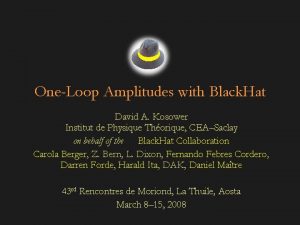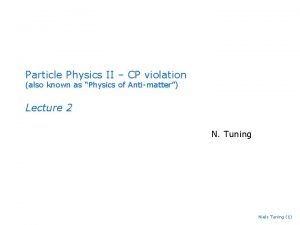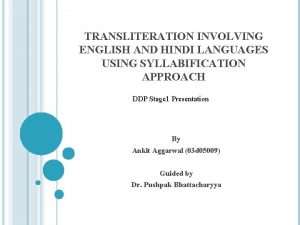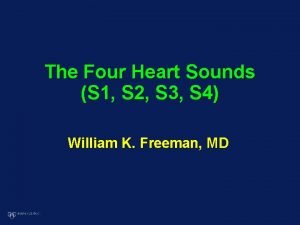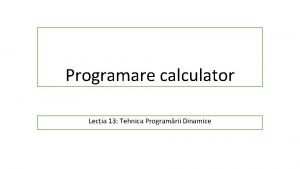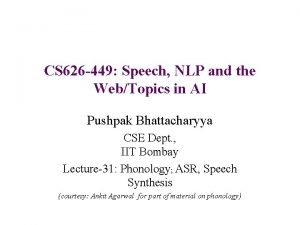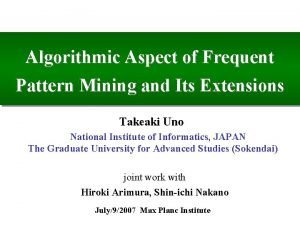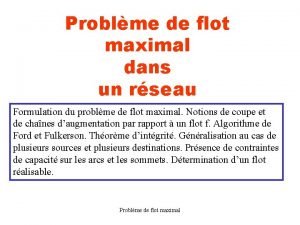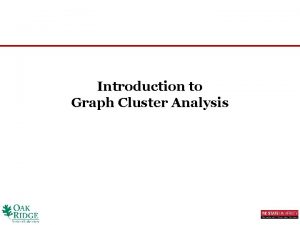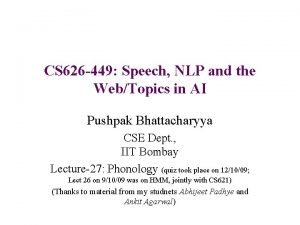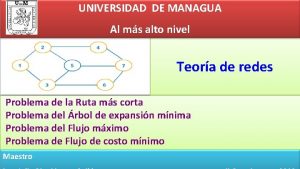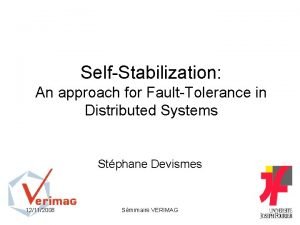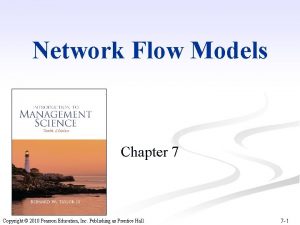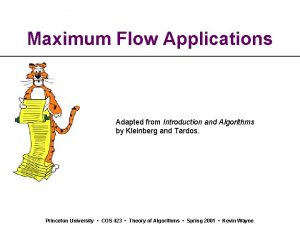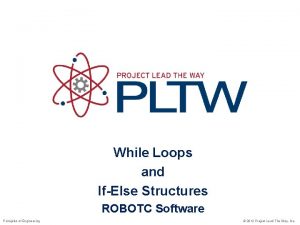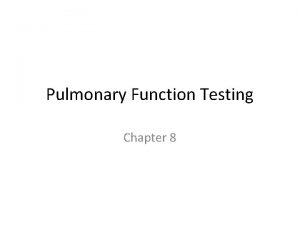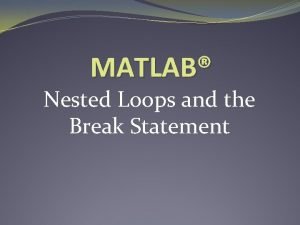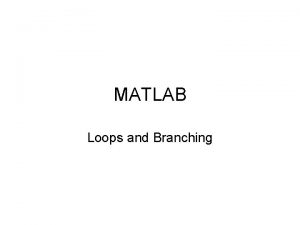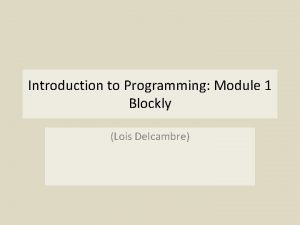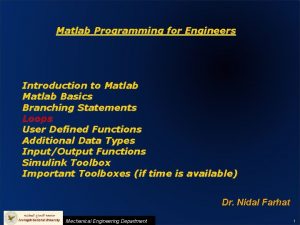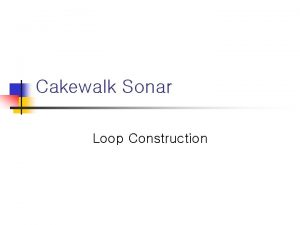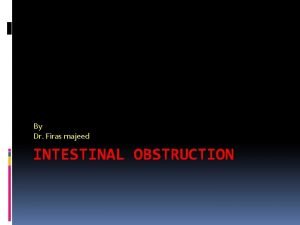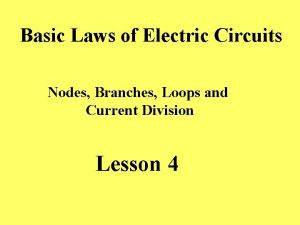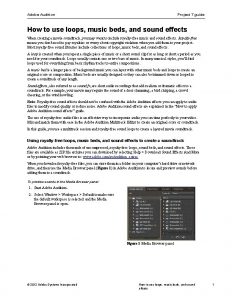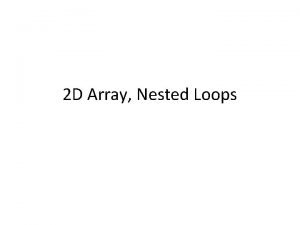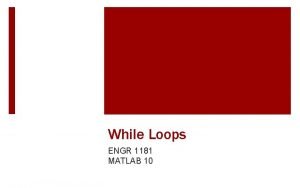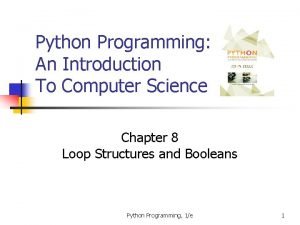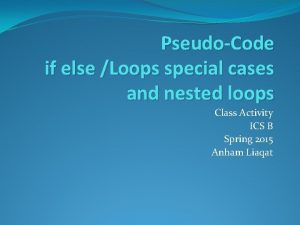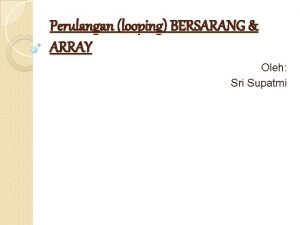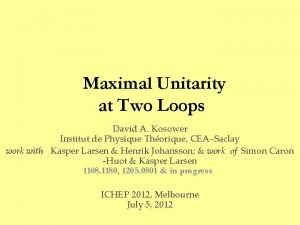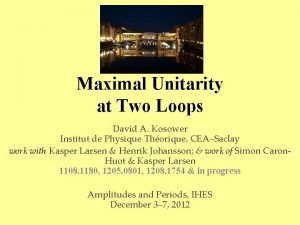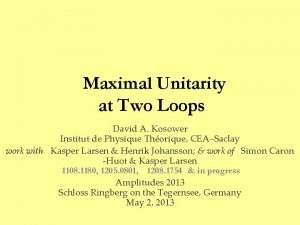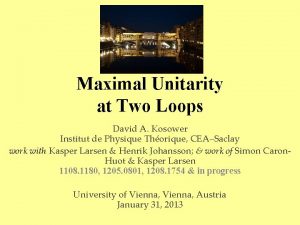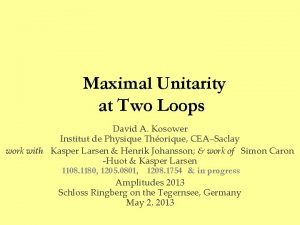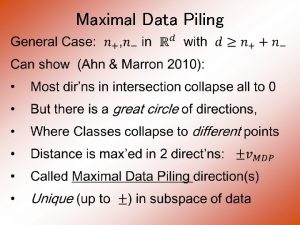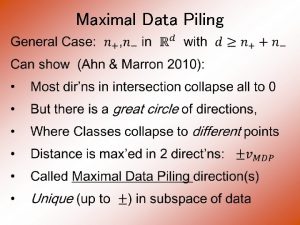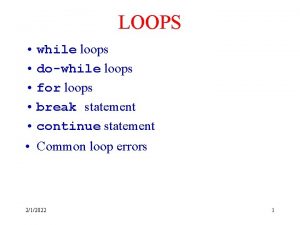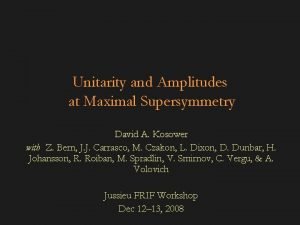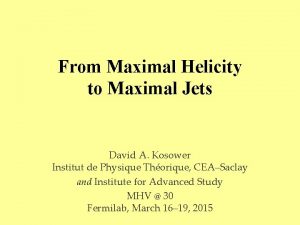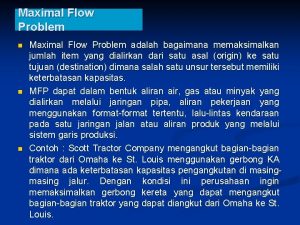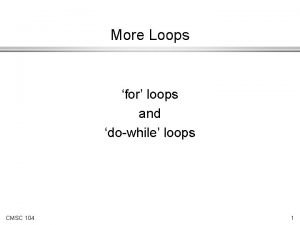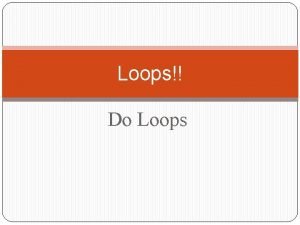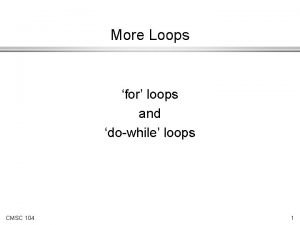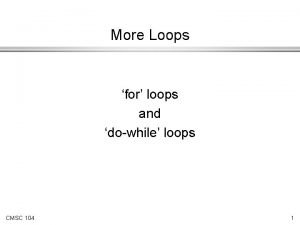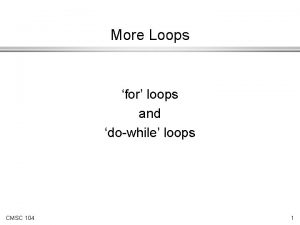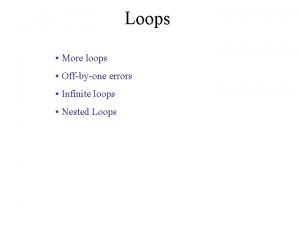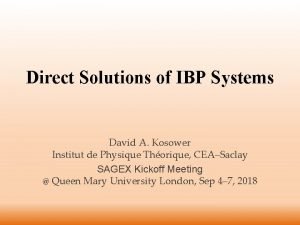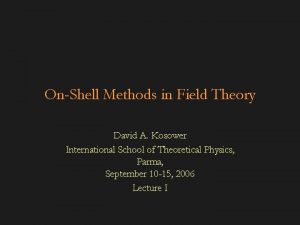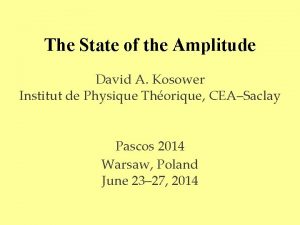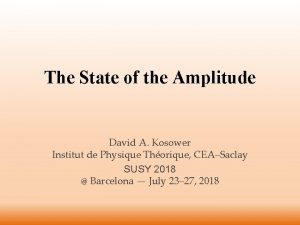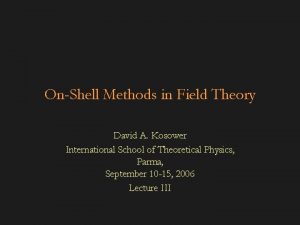Maximal Unitarity at Two Loops David A Kosower




























![• Two basis or ‘master’ integrals: I 4[1] and I 4[ℓ 1∙k 4] • Two basis or ‘master’ integrals: I 4[1] and I 4[ℓ 1∙k 4]](https://slidetodoc.com/presentation_image_h2/573726116a56d13186eed4002d74e031/image-29.jpg)








- Slides: 37

Maximal Unitarity at Two Loops David A. Kosower Institut de Physique Théorique, CEA–Saclay work with Kasper Larsen & Henrik Johansson; & work of Simon Caron. Huot & Kasper Larsen 1108. 1180, 1205. 0801, 1208. 1754 & in progress Amplitudes and Periods, IHES December 3– 7, 2012

Amplitudes in Gauge Theories • Amplitudes are the key quantity in perturbative gauge theories • Infrared-divergent but all infrared-safe physical quantities can be built out of them • Recent years have seen lots of excitement in N=4 SUSY • Basic building block for physics predictions in QCD • NLO calculations give the first quantitative predictions for LHC physics, and are essential to controlling backgrounds: require oneloop amplitudes • For some processes (gg W+W−, gg ZZ) two-loop amplitudes are needed • For NNLO & precision physics, we also need to go beyond one loop


On-Shell Methods • Use only information from physical states • Avoid size explosion of intermediate terms due to unphysical states • Use properties of amplitudes as calculational tools – Factorization → on-shell recursion (Britto, Cachazo, Feng, Witten, …) – Unitarity → unitarity method (Bern, Dixon, Dunbar, DAK, …) – Underlying field theory integral basis Known integral basis: • Formalism Unitarity On-shell Recursion; D-dimensional unitarity via ∫ mass

Unitarity of the S matrix tells us that the discontinuity of the transition matrix is expressed in terms of a simpler quantity Simpler because we get higher loop order from lower loop order; one loop from trees The on-shell method tells us how to get the full transition matrix back

In Feynman Integrals Cutkosky rules (1960 s) Each cut:

Unitarity-Based Calculations Bern, Dixon, Dunbar, & DAK, ph/9403226, ph/9409265 Replace two propagators by on-shell delta functions Sum of integrals with coefficients; separate them by algebra



Generalized Unitarity • Journey from a concept natural to physicists but strange to mathematicians — to one natural to mathematicians but strange to physicists • Can we pick out contributions with more than two propagators? • Yes — cut more lines • Isolates smaller set of integrals: only integrals with propagators corresponding to cuts will show up • Triple cut — no bubbles, one triangle, smaller set of boxes

• Can we isolate a single integral? • D = 4 loop momentum has four components • Cut four specified propagators (quadruple cut) would isolate a single box

Quadruple Cuts Work in D=4 for the algebra Four degrees of freedom & four delta functions … but are there any solutions?

Do Quadruple Cuts Have Solutions? The delta functions instruct us to solve 1 quadratic, 3 linear equations 2 solutions If k 1 and k 4 are massless, we can write down the solutions explicitly solves eqs 1, 2, 4; Impose 3 rd to find or

• Solutions are complex • The delta functions would actually give zero! Need to reinterpret delta functions as contour integrals around a global pole • Reinterpret cutting as contour modification

Two Problems • We don’t know how to choose a contour • Changing the contour can break equations: is no longer true if we deform the real contour to circle one of the poles Remarkably, these two problems cancel each other out

• Require vanishing Feynman integrals to continue vanishing on cuts • General contour a 1 = a 2

Box Coefficient Go back to master equation A B D C Change to quadruple-cut contour C on both sides Solve: No algebraic reductions needed: suitable for pure numerics Britto, Cachazo & Feng (2004)

Higher Loops • How do we generalize this to higher loops? – Basis; Generalized Unitarity • Work with dimensionally-regulated integrals – – Ultraviolet regulator Infrared regulator Means of computing rational terms External momenta, polarization vectors, and spinors are strictly four-dimensional • Two kinds of integral bases – To all orders in ε (“D-dimensional basis”) – Ignoring terms of O(ε) (“Regulated four-dimensional basis”)

Tools • Tensor reduction: reexpress tensors in terms of differences of denominators • Integration by parts (IBP): reduce powers of irreducible numerators • Gram determinants: eliminate integrals whose only independent terms are of O(ε)

A Physicist’s Adventures in the Land of Algebraic Varieties • We’re interested in the variety given by because in a certain sense, the integral’s coefficient is there S. Caron-Huot’s talk told us that in a certain sense, the expression for the integral itself is there too It turns out that the knowledge of the basis is there as well

IBP-Generating Vectors • Find vectors that generate IBP relations manifestly free of doubled propagators • Double box

Examples • Massless, one-mass, diagonal two-mass, long-side two-mass double boxes : two integrals • Short-side two-mass, three-mass double boxes: three integrals • Four-mass double box: four integrals • Massless pentabox : three integrals All integrals with n 2 ≤ n 1 ≤ 4, that is with up to 11 propagators This is the D-dimensional basis

Planar Two-Loop Integrals • Massless internal lines; massless or massive external lines

Four-Dimensional Basis • If we drop terms which are ultimately of O(ε) in amplitudes, we can eliminate all integrals beyond the pentabox , that is all integrals with more than eight propagators

Massless Planar Double Box [Generalization of OPP: Ossola & Mastrolia & Mirabella, Peraro (2011– 2); Badger, Frellesvig, & Zhang (2012); Kleiss, Malamos, Papadopoulos & Verheyen (2012)] • Here, generalize work of Britto, Cachazo & Feng, and Forde • Take a heptacut — freeze seven of eight degrees of freedom • One remaining integration variable z • Six solutions, for example

• Need to choose contour for z within each solution • Jacobian from other degrees of freedom has poles in z: naively, 14 solutions aka candidate global poles • Note that the Jacobian from contour integration is 1/J, not 1/|J| • Different from leading singularities Cachazo & Buchbinder (2005)

How Many Solutions Do We Really Have? Caron-Huot & Larsen (2012) • Parametrization • All heptacut solutions have • Here, naively two global poles each at z = 0, −χ same! • Overall, we are left with 8 distinct global poles

![Two basis or master integrals I 41 and I 4ℓ 1k 4 • Two basis or ‘master’ integrals: I 4[1] and I 4[ℓ 1∙k 4]](https://slidetodoc.com/presentation_image_h2/573726116a56d13186eed4002d74e031/image-29.jpg)
• Two basis or ‘master’ integrals: I 4[1] and I 4[ℓ 1∙k 4] • Want their coefficients

Picking Contours • A priori, we can deform the integration contour to any linear combination of the 8; which one should we pick? • Need to enforce vanishing of all total derivatives: – 5 insertions of ε tensors 4 independent constraints – 20 insertions of IBP equations 2 additional independent constraints • Seek two independent “projectors”, giving formulæ for the coefficients of each master integral – In each projector, require that other basis integral vanish – Work to O(ε 0); higher order terms in general require going beyond four-dimensional cuts

• Master formulæ for basis integrals • To O (ε 0); higher order terms require going beyond fourdimensional cuts

• Contours • Up to an irrelevant overall normalization, the projectors are unique, just as at one loop • More explicitly,

One-Mass & Some Two-Mass Double Boxes • Take leg 1 massive; legs 1 & 3 massive; legs 1 & 4 massive • Again, two master integrals • Choose same numerators as for massless double box: 1 and • Structure of heptacuts similar • Again 8 true global poles • 6 constraint equations from ε tensors and IBP relations • Unique projectors — same coefficients as for massless DB (one-mass or diagonal two-mass), shifted for long-side twomass

Short-side Two-Mass Double Box • Take legs 1 & 2 to be massive • Three master integrals: I 4[1], I 4[ℓ 1∙k 4] and I 4[ℓ 2∙k 1] • Structure of heptacut equations is different: 12 naïve poles • …again 8 global poles • Only 5 constraint equations • Three independent projectors • Projectors again unique (but different from massless or one-mass case)

Short-Side Projectors

Massive Double Boxes Massive legs: 1; 1 & 3; 1 &4 Master Integrals: 2 Global Poles: 8 Constraints: 2 (IBP) + 4 (ε tensors) = 6 Unique projectors: 2 Massive legs: 1 & 3; 1, 2 &3 Master Integrals: 3 Global Poles: 8 Constraints: 1 (IBP) + 4 (ε tensors) = 5 Unique projectors: 3 Massive legs: all Master Integrals: 4 Global Poles: 8 Constraints: 0 (IBP) + 4 (ε tensors) = 4 Unique projectors: 4

Summary • First steps towards a numerical unitarity formalism at two loops • Knowledge of an independent integral basis • Criterion for constructing explicit formulæ for coefficients of basis integrals • Four-point examples: massless, one-mass, two-mass double boxes
 David kosower
David kosower Unitarity triangle
Unitarity triangle Hindi transliteration
Hindi transliteration Point of maximal impulse
Point of maximal impulse Izzi engleski 4 razred
Izzi engleski 4 razred Heart sounds location
Heart sounds location Lsvt big video
Lsvt big video Problema triunghiului programare dinamica
Problema triunghiului programare dinamica Maximal and closed frequent itemsets
Maximal and closed frequent itemsets Phonteic alphabet
Phonteic alphabet Maximal and closed frequent itemsets
Maximal and closed frequent itemsets Flot maximal
Flot maximal Cluster analysis graph
Cluster analysis graph Webtopings
Webtopings Maximal heart rate
Maximal heart rate Maximal heart rate
Maximal heart rate Ruta mas corta
Ruta mas corta Maximal independent set
Maximal independent set Maximal flow
Maximal flow Maximal matching
Maximal matching While loops and if-else structures
While loops and if-else structures Fef 200-1200
Fef 200-1200 Reddish loops of gas
Reddish loops of gas Nested for loop matlab
Nested for loop matlab Types of loops in matlab
Types of loops in matlab Dame meaning in baa black sheep
Dame meaning in baa black sheep Perulangan python
Perulangan python Horizontal geothermal loop design
Horizontal geothermal loop design Matlab for loop example problems
Matlab for loop example problems Cakewalk loops
Cakewalk loops Featureless loop of wangenstein
Featureless loop of wangenstein What is loop in electrical circuit
What is loop in electrical circuit Adobe audition loops
Adobe audition loops Nested loops python
Nested loops python Matlab loop until condition met
Matlab loop until condition met Python sentinel loop
Python sentinel loop Loops in pseudocode
Loops in pseudocode Nested array
Nested array
